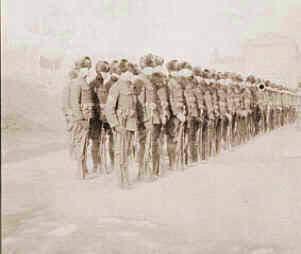MY GRANDFATHER
PFC FLOYD PFOST

AEF Siberia Patch
By
LUANN PFOST |

Private Floyd O. Pfost
31st Infantry, AEF Siberia
Grandfather was born Aug 20, 1896. Floyd's family were the first settlers in the Palo Verde Valley of California (a hot arid desert region along the Colorado river). At the age of 21 he enlisted in the Army in the border town of Calexico Ca.
As an expert rifleman in company K of the 31st Infantry Regiment on he was sent with the 31st to Siberia after training in the Philippines. He enjoyed a shore leave in Japan (Nagasaki?) en route. He said that most of Japanese he met were very friendly and he was surprised to see how many spoke excellent English. He later found it a bitter thing that these nice Japanese allies of the 31st in Siberia would become the 31sts deadliest enemy in the next war.

Company Formation
His job in Siberia was first to guard some German prisoners and then to protect the railroad from the Bolsheviks. He once got into trouble for almost shooting the officer of the day. He was very impressed with the cold winter (it being so different from his desert home and Hawaii) He was 6' 5" tall and the snow was about a foot or so higher than his head. He also mentioned the smell of the civil war buffalo overcoats the army issued made worse by the inability to clean them properly. Upon leaving Siberia, Floyd with the rest of the 31st was sent [back] to Manila in the Philippines.
He never talked much about the fighting that he saw there. His military discharge, however, indicates that he was involved in a number of skirmishes that were not large enough to be called battles, but in modern terms can probably be classified as 'fire-fights'. Interestingly, they all took place over a two-week period in the summer of 1919.
- Novonezhino, June 26 1919
- Razhdeswenko, June 30 1919
- Melenny Mys, July 1 1919
- Trigovia, July 7 1919
- Brovichi Pass, July 11 1919
- Gordienka, July 9 1919
His discharge includes a few additional facts. He avoided getting wounded in Siberia and was discharged December 27 1919, at the Presidio of San Francisco. He was paid travel allowance to Palo Verde, California. His pay upon discharge was 320.61 with a five cents per mile allowance and a $60 bonus included. When his Army enlistment was up, Floyd joined the Marines. The Marine Corps sent him to Haiti. When he left the Marines, Floyd returned home to the family homestead.

Possibly the Regimental Mascot
After the death in the flu epidemic of his parents,
and the subsequent floods that washed away the cattle and left him broke. Floyd gave up on his share of the homestead and became a master butter maker in Blythe Ca. Miss Moss first saw him carrying the flag in the 1925 veteran's parades and married him in January of 1926. Their only child was born later that year.
In the 30's he went broke again while attempting wheat farming in the central valley of California. By the 1940s he was running a country store/ restaurant/ gasoline/ bus stop in Thermal California. At this time he was also a member of the local draft board and active in the local chapter of the VFW with General Patton. Patton, who was training his troops in the nearby desert, was an active member of the local chapter until he and his men were sent overseas

Japanes Sailors & Soldiers in Siberia
Because of his fond memories of his stop in Japan he had made many friends, with the Japanese Americans who farmed in The Thermal area just prior to WWII. Floyd was against their removal and interment in Poston. He never forgave the country of Japan however for the murder of his friends, who were still with the 31st in WWII.
In the 1950s he quit store keeping and became the owner of a motel in Redlands Ca. He sold the motel and retired in the late 1970s
While he was in Siberia, Floyd sent this letter to his cousin Viola:
Vladivostok Siberia Jan, 8 1919
Dear Cousin:
Rec'd your most welcome letter yesterday, I have been in Siberia now about five months and before coming to Siberia I was at the Philippines about four months and a half.
I was only in McDowell a week till I was shipped overseas. I have seen quite a little foreign country since I left; Honolulu, Guam, P.I. [Philippine Islands] , Japan, and Siberia and it is only a little ways from here to China. I was in The Philippines in the summer months when it was the hottest and believe me it sure was hot and then was sent here to put in the winter and it sure is cold.

Siberian Barracks Scene
The bay is frozen over here so you can walk all around it and they have ice breakers to keep it open so the transports can come in. We have big skin lined coats also buffalo coats and fur caps and believe me we sure need them.
We had a big turkey Xmas also New Years. At our Xmas dinner we had music by the German prisoners of war.
At present our company is stationed in barracks at the base of supplies. This is where all the American transports dock in Siberia. They have a bunch of prisoners of war here to work unloading the boats and work in the warehouses so we have to guard them and the base. There were lots of men sent over here from camp Fremont out of the 12th 13th and 62nd Infantry [Regiments]. Was Aaron in any of these? I guess he is probably home by now. I don't know how much longer they will keep us here but I sure hope not much longer.
I sure don't like the cold weather. Well I will close for this time. Tell them all hello for me.
Your cousin Floyd
|

Reunion of Siberian Veterans at Disneyland, Nov. 1985
L to R. Joseph B. Longuevan, Jesse A. Anderson, Floyd O. Pfost,
Thomas Shervanick,
Joe J. Patterson with Clarence S. Mills, center-front
Grandfather died at home in his bed Jan 27, 1994
Sources and Thanks: Luann Pfost provided all the text and images for her article. Floyd Pfost took the photos during his tour of duty.
. |







